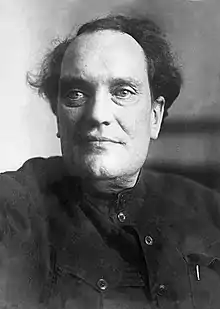Valerian Kuybyshev
Valerian Vladimirovich Kuybyshev (Russian: Валериа́н Влади́мирович Ку́йбышев; 6 June [O.S. 25 May] 1888 – 25 January 1935) was a Russian revolutionary, Red Army officer, and prominent Soviet politician.
Valerian Kuybyshev Валериан Куйбышев | |
|---|---|
 | |
| First Deputy Chairman of the Council of People's Commissars of the Soviet Union | |
| In office 14 May 1934 – 25 January 1935 | |
| Premier | Vyacheslav Molotov |
| Chairman of the Supreme Soviet of the National Economy | |
| In office 5 August 1926 – 10 November 1930 | |
| Premier | Alexey Rykov |
| Preceded by | Felix Dzerzhinsky |
| Succeeded by | Sergo Ordzhonikidze |
| Chairman of the State Planning Committee | |
| In office 10 November 1930 – 25 April 1934 | |
| Premier | Vyacheslav Molotov |
| Preceded by | Gleb Krzhizhanovsky |
| Succeeded by | Valery Mezhlauk |
| People's Commissar of the Workers' and Peasants' Inspectorate | |
| In office 6 July 1923 – 5 August 1926 | |
| Premier | Vladimir Lenin Alexey Rykov |
| Preceded by | Post established |
| Succeeded by | Sergo Ordzhonikidze |
| Full member of the 15th, 16th, 17th Politburo | |
| In office 19 December 1927 – 25 January 1935 | |
| Member of the 11th Secretariat | |
| In office 3 April 1922 – 25 April 1923 | |
| Full member of the 12th, 17th Orgburo | |
| In office 10 February 1934 – 25 January 1935 | |
| In office 26 April 1923 – 2 June 1924 | |
| Personal details | |
| Born | 6 June [O.S. 25 May] 1888 Omsk, Russian Empire |
| Died | 25 January 1935 (aged 46) Moscow, Russian SFSR, Soviet Union |
| Citizenship | Soviet |
| Nationality | |
| Political party | RSDLP (Bolsheviks) (1904-1918) Russian Communist Party (1918-1935) |
Biography
Early life
Kuybyshev was born in Omsk in the Russian Empire on 6 June [O.S. 25 May] 1888. He studied at the Omsk Military Cadet School. He joined the Bolshevik faction of the Russian Social Democratic Labour Party in 1904. The following year, he entered a military medical academy, but was expelled in 1906 for controversial political activities.
Revolutionary career
Between 1906 and 1914, Kuybyshev performed subversive activities for the Bolsheviks throughout the Empire, for which he was exiled to Narym in Siberia where—together with Yakov Sverdlov—he set up a local Bolshevik organization. In May 1912 he fled and returned to Omsk, where he was arrested the next month, and imprisoned for a year. He was transferred to Tambov to live independently under police surveillance, but soon fled again, whereafter he spent 1913–14 encouraging civil unrest in the cities of St. Petersburg, Kharkov, and Vologda; relocated to Samara in 1917; and became president of the local soviet—a position he held at the time of the October Revolution and for the next year. During the Russian Civil War he chaired the revolutionary committee of Samara province and became a political commissar in the First and Fourth Red Armies.
Political career
In 1920 Kuybyshev was elected a member of Presidium of the Red International of Trade Unions, which charged him with the implementation of the GOELRO plan. From 6 July 1923 to 5 August 1926 he was the first economical inspector of the USSR. From 1926 to 1930 he chaired the Supreme Council of the National Economy, from 1930 to 1934 he directed Gosplan, and he served as a full member of the Politburo from 1934 until his death. As a principal economic advisor to Joseph Stalin, he was one of the most influential members in the Communist Party. He was awarded the Order of the Red Banner. Kuybyshev was one of the initiators of the first edition of the Great Soviet Encyclopedia and was a member of its chief editorial board.[1]
A heavy drinker, Kuybyshev died in Moscow on 25 January 1935 of heart failure just at the age of forty-six.[2]
As Bolshevik tradition had established, he was buried outside the Kremlin walls. On the contrary, according to Stephen Kotkin in his book Stalin, Waiting for Hitler Kuibyshev was cremated, and the urn with his ashes was interred in the Kremlin Wall.
Personal life
Kuybyshev married twice, but never had any children. He was a practiced musician and poet. One of his wives was the niece of Yevgenia Bosch, Galina Aleksandrovna Troyanovskaya.
Commemoration
The city of Samara (the administrative city of the Samara Oblast, Russia), the town of Bolgar (in the Republic of Tatarstan, Russia), and the village of Haghartsin, Armenia were all renamed Kuybyshev during the period between 1935 and 1991. The towns of Kuybyshev in Novosibirsk Oblast, Russia, and Kuybyshev, Armenia, still have his name. There is a statue of him in Dushanbe, Tajikistan.[3]
References
- "Valerian Kuybyshev".
- "75 лет назад умер Валериан Куйбышев, один из организаторов сталинских репрессий". amur.info (in Russian). Retrieved 17 August 2020.
- "Google Maps". Google Maps. Retrieved 29 December 2019.
External links
![]() Media related to Valerian Kuybyshev at Wikimedia Commons
Media related to Valerian Kuybyshev at Wikimedia Commons
- Biography (in English)
- page (in Russian)
- page (in Russian)
- page (in Russian)
- Newspaper clippings about Valerian Kuybyshev in the 20th Century Press Archives of the ZBW
